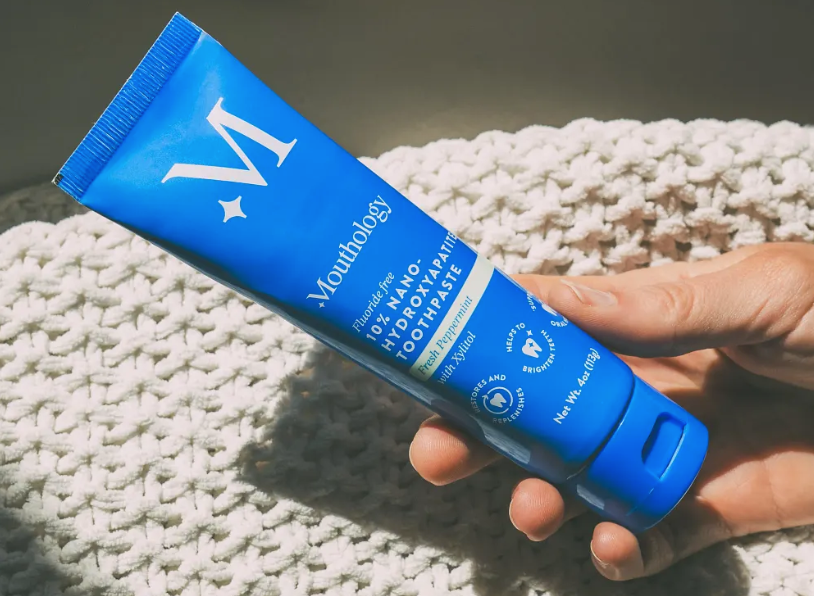Assuming you're looking for a better alternative for your fluouride-based toothpaste, you may have come across the terms "nano hydroxyapatite" and "hydroxyapatite". Many people are confused as to whether one is better than the other, or if there's any significant difference between them.
In this article, we'll explore the similarities and differences between nano hydroxyapatite and hydroxyapatite, as well as their benefits for dental health.
What is Hydroxyapatite?
Hydroxyapatite is a naturally occurring mineral form of calcium apatite, predominantly found in bones and teeth.
It plays a crucial role in bio-mineralization, contributing to the rigidity and strength of these structures. Hydroxyapatite is created through a biological process where hydroxyapatite crystals systematically align within organic tissues.
There are various forms of hydroxyapatite, including microcrystalline hydroxyapatite and synthetic hydroxyapatite. The synthetic form of hydroxyapatite can also be produced for medical and dental applications, offering benefits such as bone grafts and toothpaste additives.
Hydroxyapatite particles are instrumental in these areas due to their bio-compatibility. Understanding the differences between naturally occurring and synthetic hydroxyapatite helps in the development of advanced biomedical solutions.
What is Nano-hydroxyapatite?
On the other hand, nano-hydroxyapatite refers to hydroxyapatite particles that are on the nanometer scale. These nano particles mimic the natural mineral found in human enamel and bones but benefit from their incredibly small size, providing enhanced bio-compatibility and superior performance in medical and dental applications.
Using nano-hydroxyapatite in products like toothpaste and tablets allows for more effective remineralization of enamel. Studies have shown that the effect of nano-hydroxyapatite toothpaste is notably beneficial in not only repairing enamel but also in reducing tooth sensitivity.
The unique properties of nano-hydroxyapatite particles aid in their ability to integrate with organic tissue, making them a key component in advanced dental care solutions.
Comparing hydroxyapatite and nano-hydroxyapatite
Origin
Hydroxyapatite (HA) is derived from natural sources such as bones, marine organisms, plants, and phosphate rocks. It exists naturally in bone tissue and has been used by dentists as a bone graft material since the 1960s.
On the other hand, nano-hydroxyapatite (n-Ha) is a synthetic form of hydroxyapatite that is modified with a nano-scale crystalline structure. It is produced by synthesizing hydroxyapatite in solution followed by rapid cooling to solidify it into its nano-scale system.
Surface Area
One of the key differences when comparing hydroxyapatite and nano-hydroxyapatite is their surface area. Hydroxyapatite typically has a surface area of about 9.4 m²/g, whereas nano-hydroxyapatite boasts a much larger surface area of around 126 m²/g.
This increased surface area in nano-hydroxyapatite translates to better absorption of nutrients and improved tissue adhesion between the graft material and surrounding tissues, such as bone.
Benefits
Both hydroxyapatite and nano-hydroxyapatite offer significant benefits, particularly in the remineralization of teeth and bones. They are effective in strengthening teeth and bones and can help reverse cavities.
Nano-hydroxyapatite, due to its nano-scale structure, also provides non-toxic properties and might have added benefits like treating osteoporosis more effectively. The small particle size allows for superior bio-compatibility and integration with organic tissue.
Nano-Hydroxyapatite vs Hydroxyapatite vs Fluoride
When considering hydroxyapatite vs nano-hydroxyapatite vs fluoride in dental applications, each has its unique advantages. Fluoride has been used for decades to strengthen enamel and prevent cavities.
However, nano-hydroxyapatite offers a compelling alternative due to its ability to repair enamel more effectively and reduce tooth sensitivity, thanks to its high surface area and bio-mimetic properties. The choice between hydroxyapatite, nano-hydroxyapatite, and fluoride often depends on the specific needs of dental treatments and patient preferences.
To sum up, nano-hydroxyapatite is an advanced, synthetic variant of hydroxyapatite, offering enhanced performance due to its nano-scale properties. By understanding the differences and advantages of these materials, more effective and personalized dental and medical treatments can be developed.
Benefits of Nano-Hydroxyapatite Over Hydroxyapatite
Is one better than the other? It's tough to say, as both hydroxyapatite and nano-hydroxyapatite offer unique benefits and have different applications. However, when it comes to dental health, nano-hydroxyapatite is considered better than fluoride by many experts and users.
This is largely because people are turning to nano-hydroxyapatite toothpaste for its superior performance and bio-mimetic properties. Here are some notable benefits of hydroxyapatite and nano-hydroxyapatite:
Benefits of Hydroxyapatite:
- Natural Remineralization: Regular hydroxyapatite helps in the natural remineralization process, making it effective in strengthening teeth.
- Biocompatibility: It is highly biocompatible, reducing the risk of adverse reactions.
- Bone Grafting: It is widely used in bone grafting materials and helps in the repair and regeneration of bone tissues.
- Non-Toxic: Hydroxyapatite is non-toxic and safe for long-term use in dental and medical applications.
Benefits of Nano-Hydroxyapatite:
- Enhanced Remineralization: Nano-hydroxyapatite provides more effective remineralization of enamel compared to regular hydroxyapatite.
- Reduction of Tooth Sensitivity: Its small particle size allows it to fill in tiny cracks and breaches in the enamel, significantly reducing tooth sensitivity.
- Better Integration: Nano-hydroxyapatite integrates more seamlessly with natural teeth and bones due to its nano-size structure.
- Non-Toxic and Safe: Like its larger counterpart, it is non-toxic and safe for use as a dental treatment.
- Superior Bio-Mimetic Properties: Nano-hydroxyapatite mimics the natural mineral composition of human teeth, making it a better alternative to fluoride for many applications.
- Effective as Fluoride: In toothpaste, nano-hydroxyapatite can be as effective as fluoride in preventing cavities and other dental issues.
Given these advantages, it is not surprising that many people are turning to nano-hydroxyapatite toothpaste as a better alternative to traditional fluoride-based products.
While hydroxyapatite in its regular form is highly beneficial, the additional benefits and enhanced performance of nano-hydroxyapatite often make it the preferred choice for modern dental care solutions.
Should You Ditch Your Fluoride Toothpaste for Nano-hydroxyapatite Toothpaste?
With the benefits of nano-hydroxyapatite gaining attention, many are questioning whether to replace their traditional fluoride toothpaste. Concerns about fluoride toxicity have fueled this debate. Fluoride in water has long been a public health measure, but it comes with drawbacks. Sodium fluoride and amine fluoride are common in dental care, yet they can be associated with adverse effects.
Amine fluoride toothpaste, while effective, has not completely eliminated concerns. Moreover, fluoride control toothpaste often faces scrutiny, with some studies suggesting it might be inferior to a fluoride control standard.
Unlike fluoride, nano-hydroxyapatite presents a promising alternative. Nano silver particles in some oral care products have shown potential, yet nano vs. traditional fluoride is still an ongoing discussion.
Fluoride and hydroxyapatite together can provide comprehensive benefits. However, nano-hydroxyapatite alone is proving to be an effective contender. The nano hydroxyapatite is equally effective as fluoride in remineralizing initial enamel fissures, reducing tooth sensitivity, and preventing dental caries.
With fluoride control toothpaste facing criticism, including potential fluoride toxicity, and concerns about fluoride in water, the dental community is increasingly considering nano-hydroxyapatite. It offers similar benefits without the associated risks, making it an attractive option for oral health care.
Thus, while both have their merits, the shift towards nano-hydroxyapatite is gaining momentum.
When is Hydroxyapatite Toothpaste a Better Choice?
If You Are Sensitive to Fluoride
If you are sensitive to fluoride, using hydroxyapatite toothpaste is a wise choice. The lack of fluoride reduces the risk of adverse reactions, making it an effective and safe alternative for maintaining oral hygiene. Hydroxyapatite mimics the natural composition of teeth, offering a gentle yet powerful way to protect and remineralize the enamel surface.
If You Are Concerned About the Risk of Your Young Children Accidentally Swallowing Fluoride Toothpaste
For parents worried about the risk of their young children accidentally swallowing fluoride toothpaste, hydroxyapatite provides peace of mind. Unlike fluoride, hydroxyapatite is non-toxic and safe if ingested, making it an excellent option for young children. This ensures your child's oral hygiene routine is both effective and safe.
If You Are Pregnant
Pregnant women may consider switching to hydroxyapatite toothpaste to avoid potential fluoride exposure risks. The unique properties of hydroxyapatite nanoparticles ensure maintaining strong enamel surfaces while being gentle on the body. This choice safeguards both maternal and fetal health during a critical period.
If You Have Concerns About Your Oral Microbiome
For those with concerns about their oral microbiome, hydroxyapatite toothpaste can offer substantial benefits. Fluoride can sometimes disrupt the bacterial balance in the mouth, but hydroxyapatite helps support a healthy oral environment. It works by placing calcium phosphate on the teeth, bolstering the enamel surface without disturbing the beneficial bacteria.
If You Prefer a Natural Alternative
Hydroxyapatite is also an excellent choice for individuals seeking a more natural oral hygiene product. It is derived from naturally occurring minerals and integrates seamlessly with the teeth, providing a holistic approach to dental care.
Closing Thoughts
There's no denying the benefits of both fluoride and hydroxyapatite toothpaste in promoting oral health. Each has its unique advantages, and the choice often depends on individual needs and preferences.
While fluoride has been a cornerstone of dental care for decades, hydroxyapatite offers a natural and equally effective alternative. For those uncertain about which option to choose, it's always best to consult with a dental professional to determine the most suitable solution for your specific situation.

